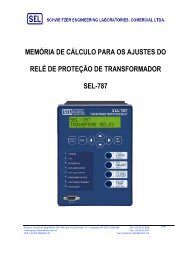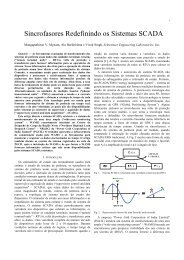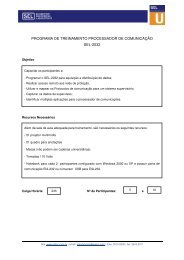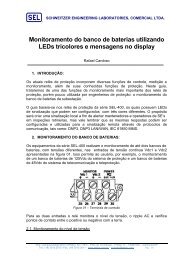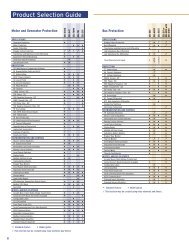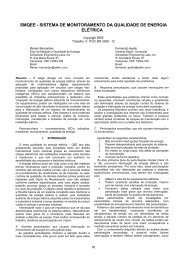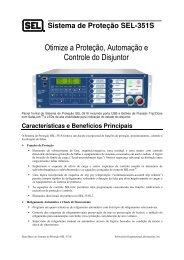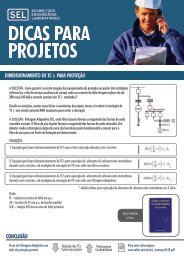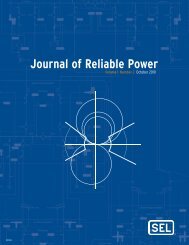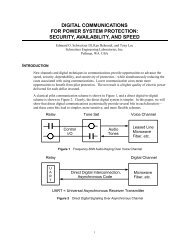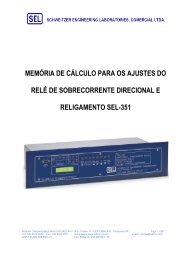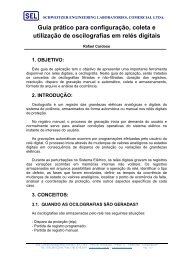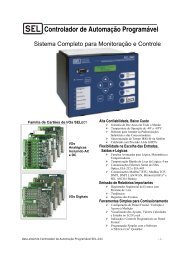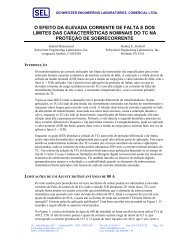Journal of Reliable Power - SEL
Journal of Reliable Power - SEL
Journal of Reliable Power - SEL
Create successful ePaper yourself
Turn your PDF publications into a flip-book with our unique Google optimized e-Paper software.
Impedance-Based Fault Location Experience<br />
Karl Zimmerman and David Costello, Schweitzer Engineering Laboratories, Inc.<br />
I. INTRODUCTION<br />
Accurate fault location reduces operating costs by avoiding<br />
lengthy and expensive patrols. Accurate fault location<br />
expedites repairs and restoration <strong>of</strong> lines, ultimately reducing<br />
revenue loss caused by outages.<br />
In this paper, we describe one- and two-ended impedancebased<br />
fault location experiences. We define terms associated<br />
with fault location, and describe several impedance-based<br />
methods <strong>of</strong> fault location (simple reactance, Takagi, zerosequence<br />
current with angle correction, and two-ended<br />
negative-sequence). We examine several system faults and<br />
analyze the performance <strong>of</strong> the fault locators given possible<br />
sources <strong>of</strong> error (short fault window, nonhomogeneous<br />
system, incorrect fault type selection, etc.).<br />
Finally, we show the laboratory testing results <strong>of</strong> a twoended<br />
method, where we automatically extracted a two-ended<br />
fault location estimate from a single end.<br />
II. FAULT LOCATION METHODS AND DEFINITIONS<br />
Several methods <strong>of</strong> estimating fault location are presently<br />
used in the field:<br />
• DFR and short circuit data match<br />
• Traveling wave methods<br />
• Impedance-based methods<br />
− One-ended methods without using source<br />
impedance data (simple reactance, Takagi)<br />
− One-ended methods using source impedance data<br />
• Two-ended methods<br />
In this paper, we focus on certain impedance-based fault<br />
location methods and provide results from actual system<br />
faults.<br />
III. NOTABLE IEEE DEFINITIONS<br />
IEEE PC37.114, “Draft Guide for Determining Fault<br />
Location on AC Transmission and Distribution Lines”[1] was<br />
recently balloted and is in the approval process. One <strong>of</strong> the<br />
important contributions <strong>of</strong> the guide is the definitions section.<br />
Here are a few notable definitions found in the guide:<br />
Fault location error: Percentage error in fault location<br />
estimate based on the total line length: e (error) = (instrument<br />
reading – exact distance to the fault) / total line length.<br />
For example, suppose a line is 100 miles long and the<br />
actual fault is 90 miles from the local terminal. If the local<br />
fault locator provides a fault location <strong>of</strong> 94 miles, the fault<br />
location error is (94–90)/100 = 4%. If the remote fault locator<br />
indicates 8 miles, the fault location error is (8–10)/100 = 2%.<br />
Homogeneous line: A transmission line where impedance<br />
is distributed uniformly on the whole length.<br />
Examples <strong>of</strong> this are lines that use the same conductor size<br />
and construction throughout. Lines that are nonhomogeneous<br />
can be a source <strong>of</strong> error for one- or two-ended impedancebased<br />
fault location methods.<br />
Homogeneous system: A transmission system where the<br />
local and remote source impedances have the same system<br />
angle as the line impedance. A homogeneous system is shown<br />
in Figure 1.<br />
Z<br />
Z<br />
Figure 1<br />
1S<br />
0S<br />
Z 1S<br />
= 2∠80°<br />
= 3 • Z<br />
1S<br />
Relay<br />
mZ 2L<br />
Z<br />
Z<br />
1L<br />
0L<br />
R F<br />
(1-m)Z 2L<br />
= 8∠80°<br />
= 3• Z<br />
Example <strong>of</strong> a Homogeneous System<br />
1L<br />
Relay<br />
∠Z<br />
∠Z<br />
1R<br />
0R<br />
Z 1R<br />
= ∠Z<br />
1S<br />
= ∠Z<br />
Nomograph: A graph that plots measured fault location<br />
versus actual fault location by compensating for known<br />
system errors.<br />
Figure 2 shows a 69 kV line with 12.47 kV underbuild.<br />
Figure 2<br />
Relay<br />
Location<br />
N<br />
69 kV Line Configuration Sketch<br />
N<br />
69 kV<br />
0S<br />
12.47 kV<br />
Load<br />
How to build a nomograph:<br />
1. Calculate line constants.<br />
2. Determine which faults require a nomograph.<br />
3. Using short circuit program, apply faults along the<br />
length <strong>of</strong> line (10%, 20%, etc.).<br />
4. Plug resultant voltage and current values into fault<br />
location algorithms.<br />
5. Plot a short circuit (actual) vs. calculated (relay)<br />
fault location.<br />
Impedance-Based Fault Location Experience | 15



